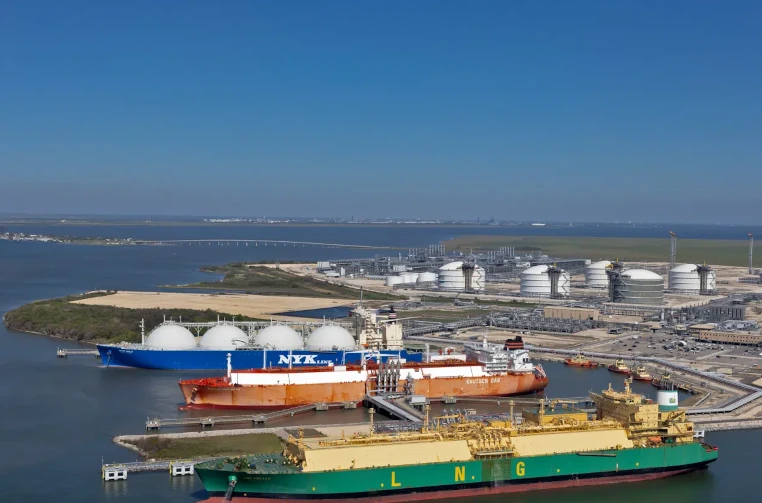On my latest flight surveying fossil fuel industry sites in southwest Louisiana at the end of September, I photographed liquified natural gas (LNG) export facilities, signs of drought, fire-scarred stretches of marsh, and a salt dome site at risk of collapsing. The visuals illustrate many issues that climate advocates publicized this week related to dangerous impacts fossil fuel industry sites are having on the environment.
First, on October 19, the Louisiana Bucket Brigade called out the Federal Energy Regulatory Committee (FERC) for granting Venture Global’s request to construct its Plaquemines LNG gas export terminal on a 24/7 construction schedule. The decision comes after Plaquemines Parish faced a months-long water crisis due to a major saltwater wedge in the Mississippi River.
“The Federal Energy Regulatory Agency is supposed to keep oil and gas companies in line, yet here they are rubber stamping another dangerous request from a delinquent gas export company,” said Anne Rolfes, the director of the Bucket Brigade. “We are disappointed and disgusted to see FERC once again destroy the Louisiana coast and transform it into an industrial wasteland.”
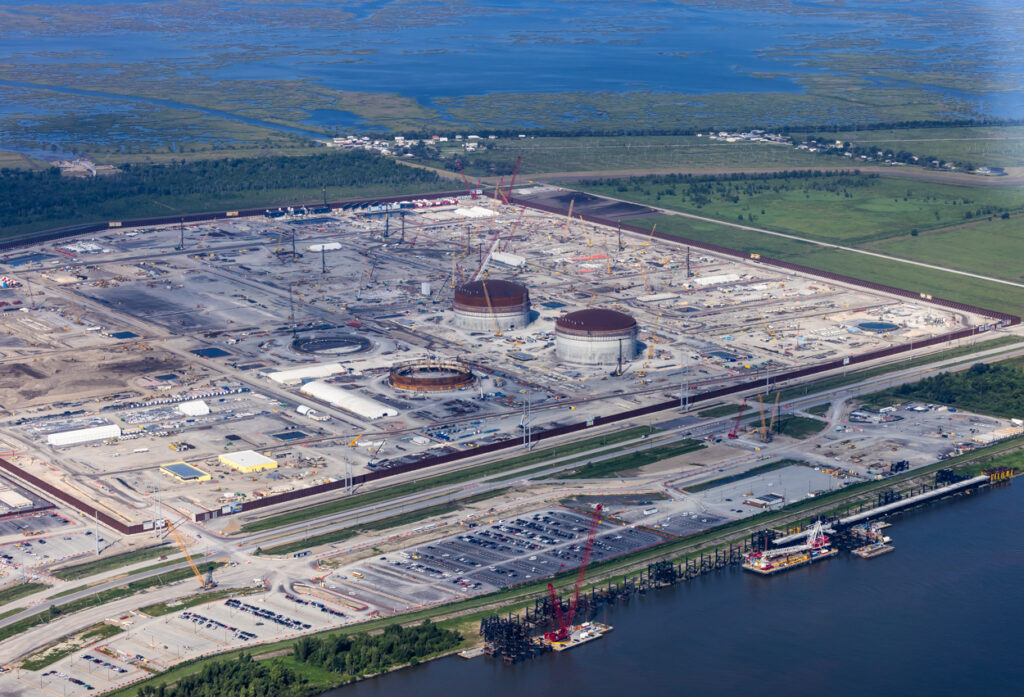
Site of Venture Global’s Plaquemines Parish LNG export facility under construction, on June 4, 2023. Credit: Julie Dermansky/Flight made possible by Southwings
FERC’s move comes just two days after the Bucket Brigade sponsored a press call with reporters concerning LNG plant development in the region. During the call, world-renowned climate activist Bill McKibben described the government’s potential permitting of Venture Global’s CP2 LNG terminal in nearby Cameron Parish, and the entire LNG industry, as “obscene and dangerous.”
He and other participants on the call are urging the Biden administration to deny permits for the $13.5 billion CP2 site and other LNG export facilities in the area. McKibben explained that an increasing number of wells will need to be fracked to produce the natural gas needed to fill the demand for LNG resulting from the growing number of export facilities.
“This is obviously an environmental justice train wreck,” McKibben said. “The last thing that people in these communities need is another project of this magnitude shoved down their throats. The ongoing treatment of the Gulf Coast as a sacrifice zone for the fossil fuel industry is just despicable and [it’s] time for it to end.”
McKibben described the expansion of the LNG export industry on the Gulf Coast as an “enormous carbon and methane bomb.” He said most people don’t understand the magnitude these fossil fuel industry sites have on the environment.
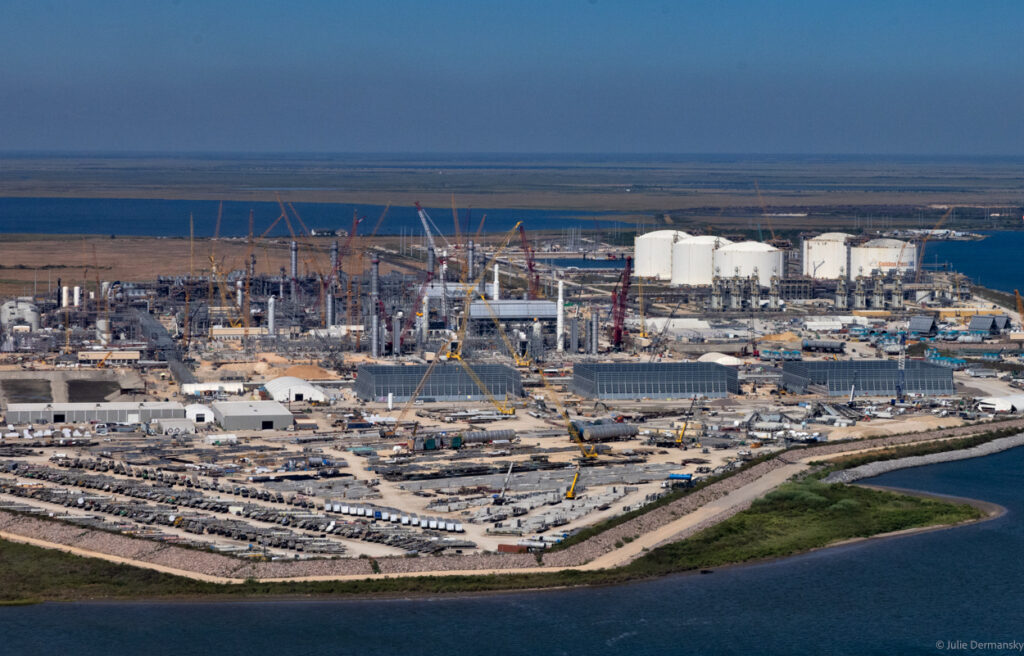
Golden Pass LNG export facility under construction in Texas, across the Sabine Pass from Louisana on September 30, 2023. Credit: Julie Dermansky/Flight by Southwings
Speakers on the call asserted that President Joe Biden’s support for increasing the country’s capacity to export LNG is contrary to the administration’s own climate agenda, which calls for a shift towards clean energy.
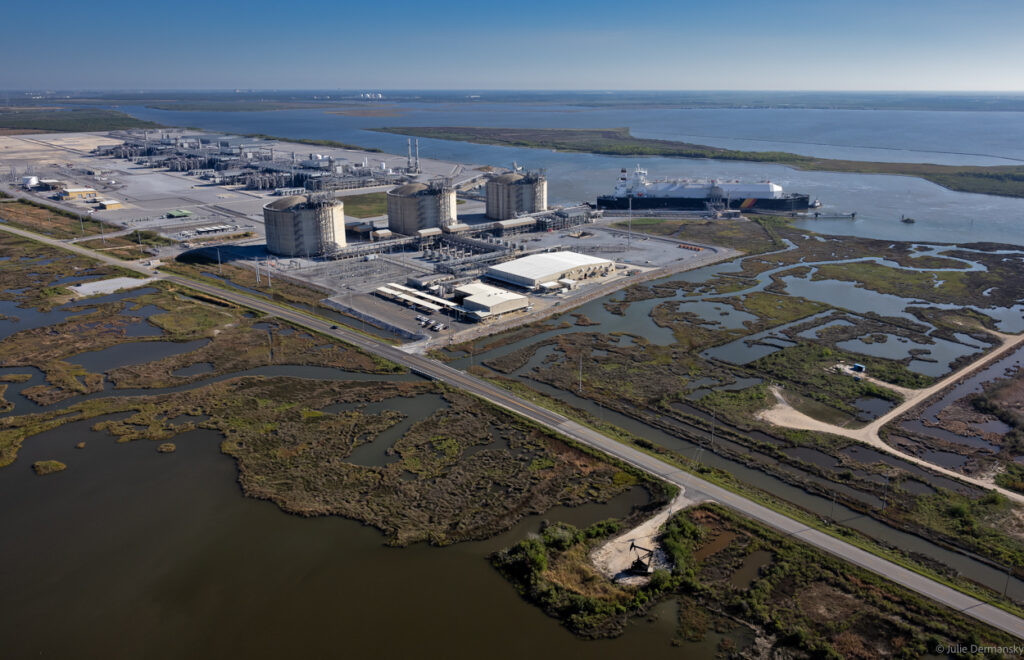
Cameron LNG in Hackberry, one of three LNG exports facilities currently operational in Southwest Louisiana on September 30, 2023. Credit: Julie Dermansky/Flight by Southwings
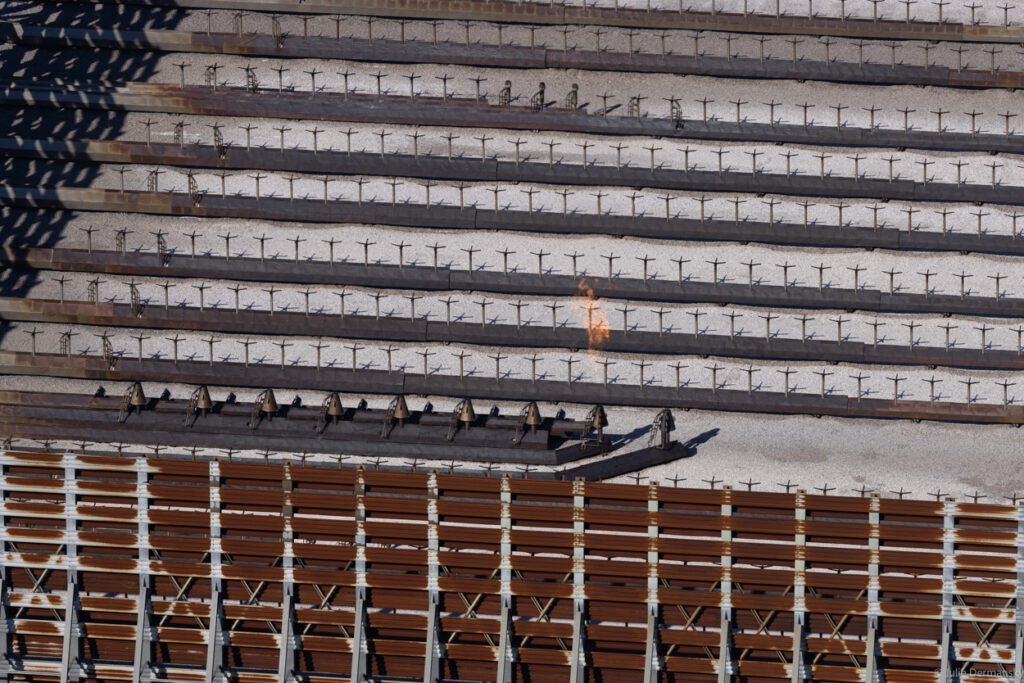
A ground flare at Cameron LNG in Hackberry on September 30, 2023. Credit: Julie Dermansky/Flight by Southwing
John C. Allaire is an environmental engineer who can see Venture Global’s Calcasieu Pass LNG export facility from his property in Cameron Parish, and helps the Louisiana Bucket Brigade raise awareness about the environmental health impacts the expanding LNG export industry is having on the Gulf Coast. He pointed out that the U.S.’s record-breaking LNG exports are driving an increase in prices for natural gas, raising an alarm that additional LNG export facilities will lead to further price increases, potentially creating scarcity issues and hardships for low-income users.
Allaire noted Virginia-based Venture Global reported the Calcasieu Pass facility had 139 air permit violations of accidental pollutant releases in 2022, one of many reasons that the Federal Energy Regulatory Commission (FERC) should deny permits for the company’s other proposed projects in the Gulf region. This includes CP2, which FERC is expected to decide on soon.
I asked Allaire if a recent fire that charred the wetlands close to his home, and the grounds surrounding Venture Global’s Calcasieu Pass facility, led to the terminal’s shut down. He said no, but the fires are worrisome. “The wind will lift the flaming ashes 40 feet in the air, and flaming ash can hit spots on the site where methane could be leaking, which could lead to an issue at the site,” he said.
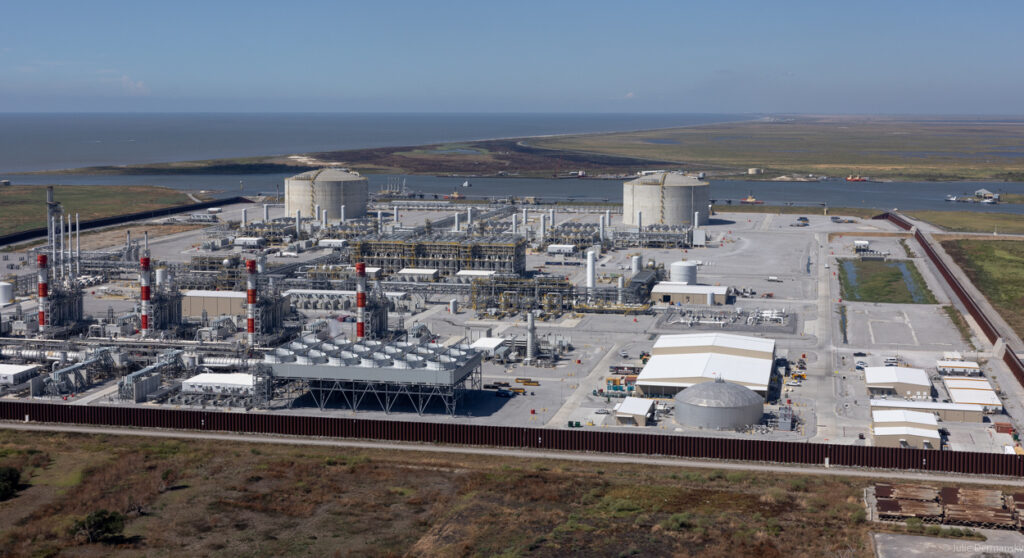
Venture Global’s Calcasieu Pass facility on September 30, 2023. Credit: Julie Dermansky/Flight by Southwings
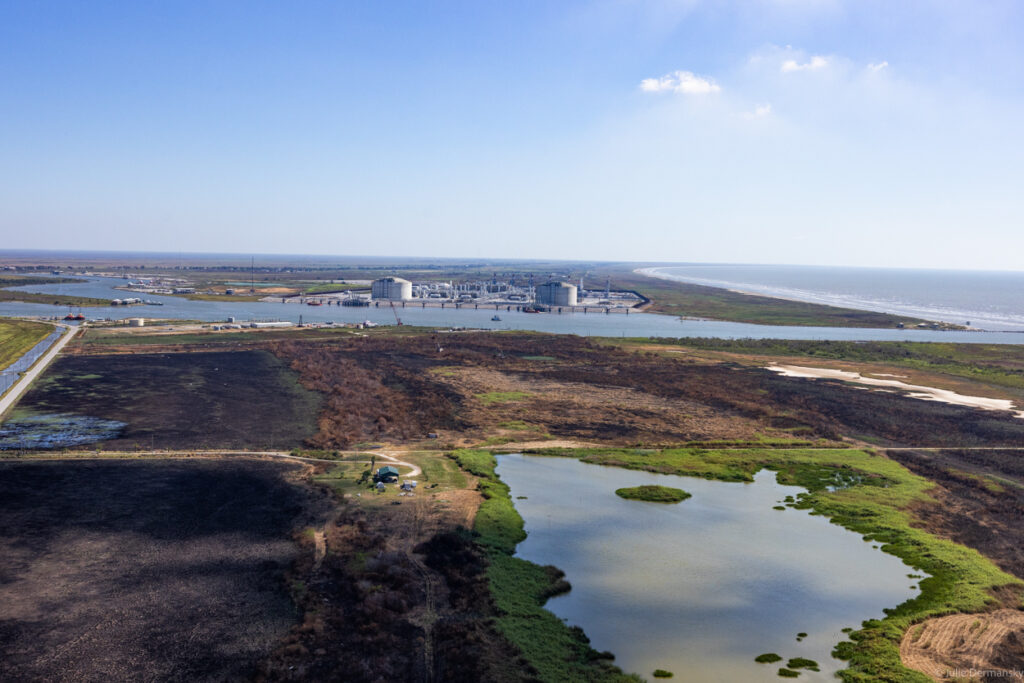
Charred landscape on both sides of the Calcasieu Pass September 30, 2023. Credit: Julie Dermansky/Flight by Southwings.
I emailed Greg Langley, spokesperson for the Louisiana Department of Environmental Quality (LDEQ), and Shaylyn Hyne, a spokesperson for Venture Global, to ask if a recent marsh fire had any impact on the Calcasieu Pass facility.
“In short, No,” Langley stated in an email, asserting that no fires ever appeared close to the Calcasieu Pass facility.
Hyne didn’t reply to my email, but offered harsh criticism to reporters about comments made during the Bucket Brigade press conference.
“The well-funded environmental activists opposing CP2 and all U.S. LNG projects are completely out of touch with reality,” she said, according to The Washington Post. “Ironically, Mr. McKibben and other activists who claim to want to lower global emissions are actually advocating for restricting access to a cleaner form of energy.”
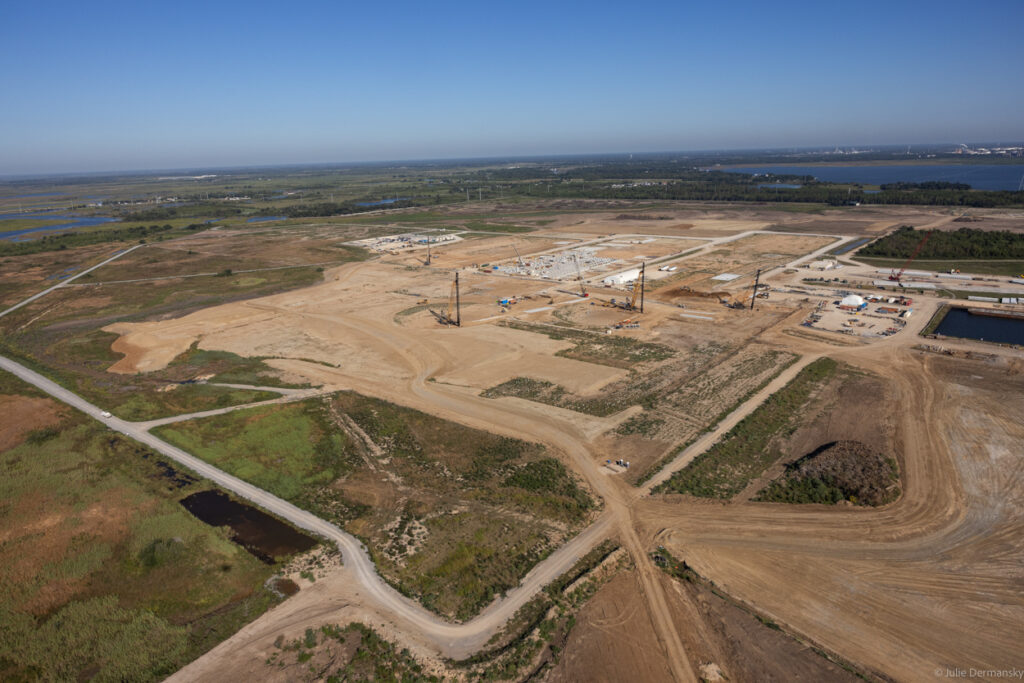
Driftwood’s LNG export facility under consruction, just south of Lake Charles, September 30, 2023. Credit: Julie Dermansky/Flight by Southwings.
Hyne asserts that replacing coal with natural gas is good for the climate. But that theory has been debunked time and time again. Scientific studies show that methane, the main component of natural gas, is up to 86 times more potent than carbon dioxide in the first 20 years after entering the atmosphere.
The Biden administration recognizes that methane emissions must be rapidly curtailed to combat the climate crisis. His administration has proposed stricter regulations to lower methane emissions, but it is unclear when, if ever, the proposed rules will ever be enacted. Yet, his administration continues to support new fossil fuel developments, including LNG export terminals, making climate activists doubt his sincerity.
If the government approves numerous permits for LNG export facilities under consideration, not only will these develpments increase climate-warming emissions, they will also raise potential health risks associated with exposure to air pollution, including cancer and respiratory diseases. Additionly, living in proximity to sites where an accident or failure could lead to an environmental catastrophe, can raise stress levels of residents.
Fenceline communities in Louisiana often reference past environmental disasters tied to the oil and gas industry they have contended with, including the BP oil spill, the Bayou Corne Sinkhole, and a recent fire at the Marathon Refinery in St. John the Baptist Parish.
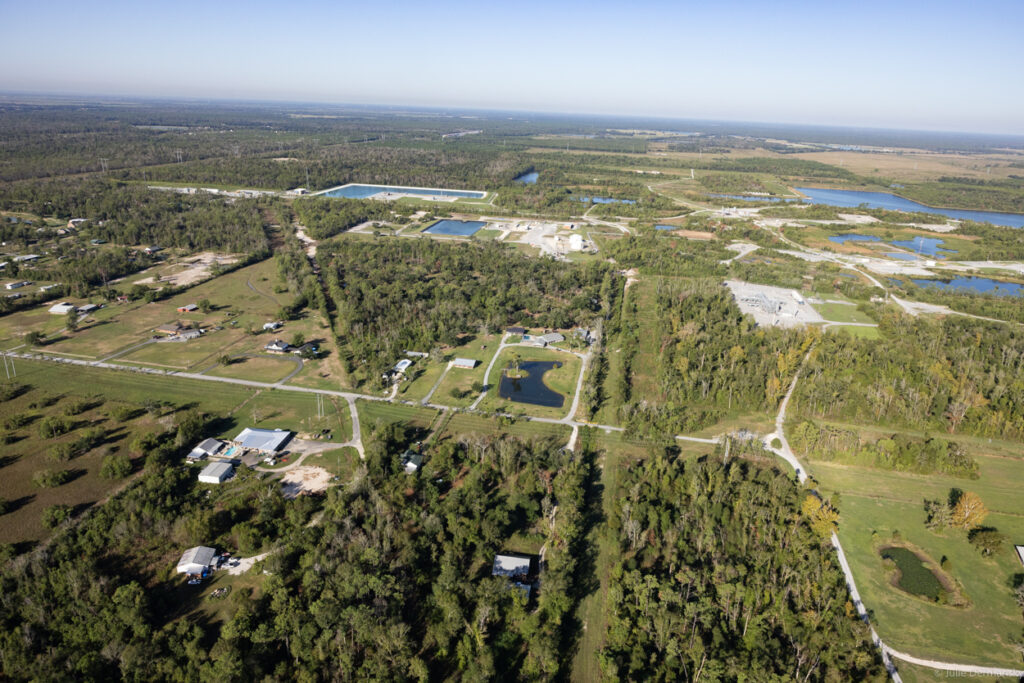
View of the Sulphur Mines salt dome Site on September 30, 2023. Credit: Julie Dermansky/Flight by Southwings
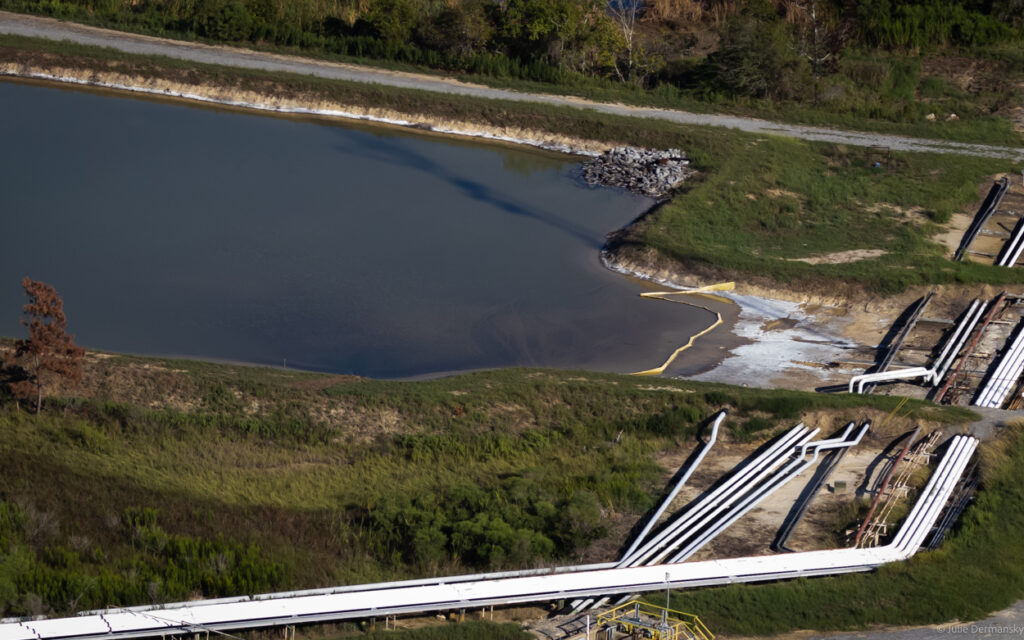
Oil and brine visible at the Sulphur Mines salt dome site on September 30, 2023. Credit: Julie Dermansky/Flight by Southwings
After the Bucket Brigade press call, on October 18 and 19, environmental advocates from across Louisiana took part in a summit hosted by the nonprofit group Micah 6:8 Mission. The meetings focused on sharing information about potential environmental and health impacts of the compromised Sulphur Mine salt dome in Calcasieu Parish. Salt domes are large, ancient formations of salt in the ground that are used for the commercial mining of petroleum, salt, and sulfur, according to the U.S. Army Corps of Engineers.
Aerial photos I shot show oil and brine in some of the water bodies on the surface of the Sulphur Mine dome site, areas with debris, and workers tending to wells.
Dee Dee Thibeaux, a summit attendee who lives two miles from the salt dome site, told me she only heard about the troubled dome the morning the summit began. She said she spoke to 15 other residents attending the summit, who said they learned only just a few days ago about the risks to their drinking water, which could already be contaminated, if the dome collapses.
News about the compromised dome broke on Sept 20, when Louisiana Gov. John Bel Edwards (D) issued an emergency declaration, which enabled the Department of Natural Resources (DNR) to take actions necessary to respond to issues at the site. The declaration noted that “the gas bubbling and cavern mechanical integrity concerns are indicators of a potential threat to groundwater in the area.”
With the declaration, funds will be available “to expedite efforts to bring in experts and resources to understand both what is happening deep underground now, and what it might mean for future stability of caverns in the area,” according to a news release from the governor’s office that states there are no signs of imminent collapse at the site.
The Commissioner of Conservation, Monique Edwards, who oversees DNR, echoed the governor’s message, stating, “Nothing we are seeing out there indicates we are past the point of no return on the structural integrity of these caverns yet.”
On a call, DNR spokesperson Patrick Courreges explained to me that the agency hasn’t seen indications that things are getting worse at the site, but it is impossible to fully determine the risk of the salt dome collapsing until experts they are in the process of hiring can collect the data needed to determine if any of the issues at the site can be repaired.
Courreges said the site has a long history of use connected to the fossil fuel industry, pointing out that DNR inherited the problem. Two caverns that were originally drilled as brine-mining wells to supply salt water to the petrochemical industry in the mid-1950s were purchased by the Department of Energy, to be used as one of the sites for the Strategic Petroleum Reserve (SPR). Crude oil was deposited there in 1979. The DOE stopped using the caverns in the early 1990s. Then Houston-based Westlake Chemical mined the site for brine until 2014, and brine from its operations remains under the site as well.
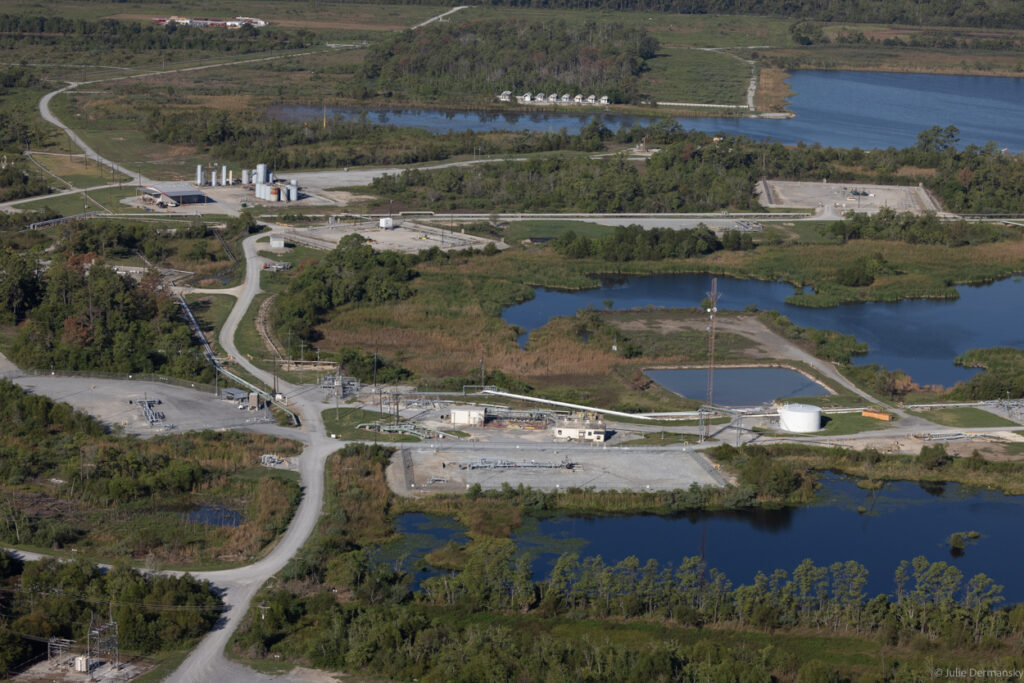
Detail of the Sulphur Mines salt dome site September 30, 2023. Credit: Julie Dermansky/Flight by Southwings
An operator from Westlake notified DNR in December 2021 of pressure anomalies at the site. Since then, “We knew something funky was happening,” Courreges said. The agency began noticing methane releases bubbling up around monitor wells that basic methane handheld monitors picked up. Oil and brine continue to be found on the surface of water bodies at the site, and in other areas, as it continues to seep out of the compromised site.
Similar issues were seen at Bayou Corne, where a salt dome collapsed in 2012, opening up a giant sinkhole and spreading gas under the homes of residents in the area. But Courgesse assured me that before the dome collapse in Bayou Corne, seismic activity was apparent, which isn’t the case at the Sulphur Mine salt dome site. The bubbling methane isn’t nearly as bad, he said, and the methane emissions at the site are also not as bad.
The summit informed the public that DNR is not measuring the amount of methane being emitting, or testing the air for other chemicals that could be emitting at the site. It isn’t testing local water wells for contaminants either, which residents at the summit found concerning. But since the emergency declaration was made, new monitoring wells are being put in place that will soon provide information about the possible spread of contaminants in waterways and the aquifer.
Wilma Subra, an environmental adviser who has worked with fenceline communities across the country for decades, told me that when the DOE was in charge of the SPR, it left most of the oil deposited at the site behind when the site closed. The selection of the site was based on politics, not science, even though the site was not suitable to store oil, she said.
Similarly, after the Ukraine war started, political support for LNG export terminals increased, despite warnings that new fossil fuel projects should not be developed to stave off the worst impacts of climate change.The perceived need to supply European nations with natural gas overshadowed the need to combat the climate crisis.
The DOE was under pressure during the 1970s to store extra oil in response to the U.S. oil and gas shortages. Subra said the Sulpher Mine salt dome site should never have been selected to be part of the DOE’s SPR project. The DOE was warned the site wasn’t appropriate, but they used it anyway – a decision she said reflected politics, not science. Shortly after the oil was deposited it became clear that removing it was very difficult and expensive. Courreges agreed that the site was not an ideal location for oil storage, and with the technology available today, the state would not have permitted the site to store oil.
He told me that the SPR has removed most of the oil. The experts they hire will try to assess how much more oil and other substances are in the dome. But just how much remains at the site isn’t of great importance to him, he said. Any oil is too much oil, “whether it’s 10,000, 50,000 or a 100,000 barrels, it’s too much oil to be in the aquifer if it gets out,” Courreges said. Remaining brine at the site is also of concern. If they contaminate the aquifer, the damage is likely causing irreversible damage.
Methane or Crude Oil Could Affect Freshwater
When the Bayou Corne salt dome collapsed in 2012, Courreges described the environmental impact to me.
“If there’s a failure in that cavern, you’ve got a lot of saltwater that could suddenly be in contact with freshwater,” he said. “There may be hydrocarbons, methane, or crude oil along the side of the dome that have been in traps and able to move upwards and affect freshwater.”
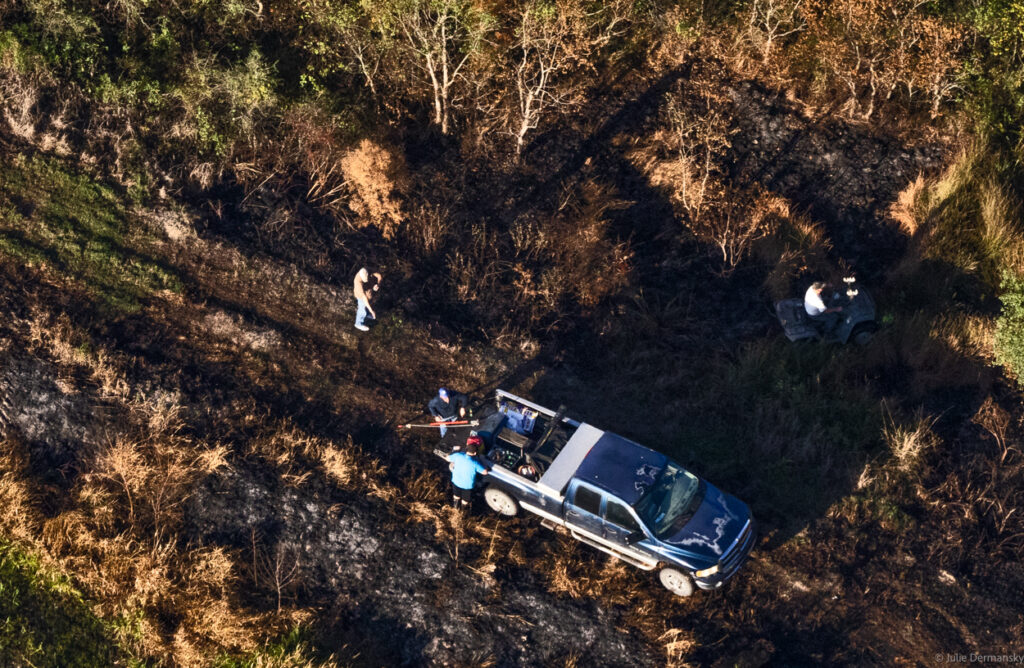
Workers at the Sulphur Mines salt dome site on September 30, 2023. Credit: Julie Dermansky/Flight by Southwings
Subra believes the oil and brine already seeping from the Sulphur salt dome could be spreading into nearby water bodies and the aquifer already, seepage that could have begun years ago. She thinks that ongoing monitoring of the air and water also should have started years ago. Without data about what is in the water and air right now, it is impossible for nearby residents and the contractors at the site to know if they are being exposed to harmful chemicals. She thinks air monitoring should occur for “volatile organics, and a whole host of methane-associated chemicals.”
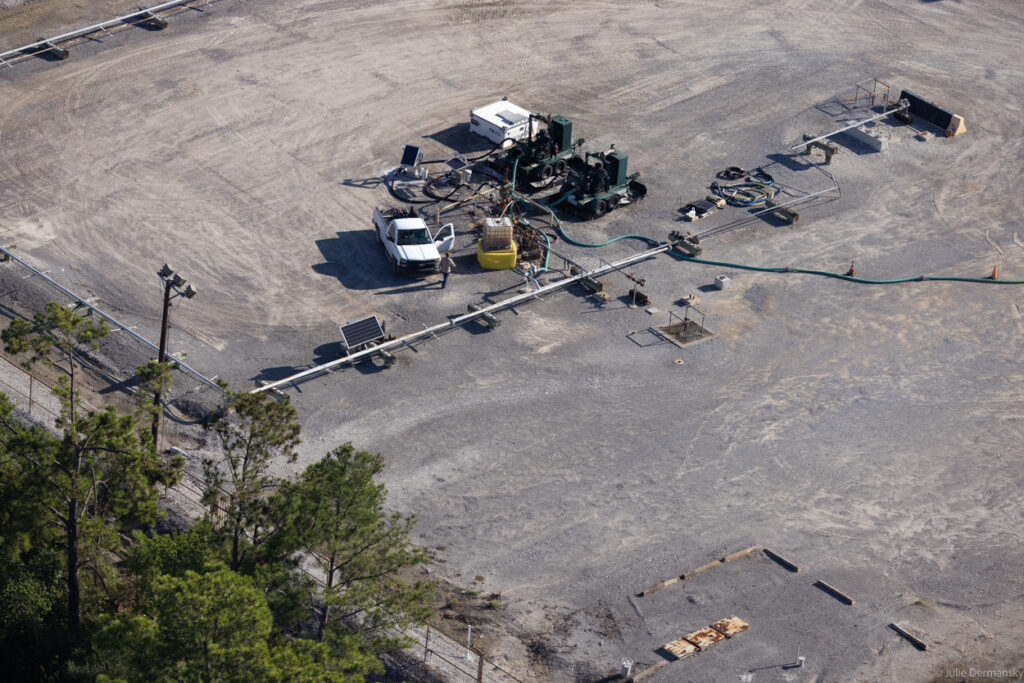
Monitoring at a the Sulphur Mines salt dome site on September 30, 2023. Credit: Julie Dermansky/Flight by Southwings
Environmental advocates involved in raising awareness related to fossil fuel industry sites in Louisiana this week, see the actions taken by regulators tasked at protecting the environment as inadequate. Subra doesn’t think the public is being made aware of the dangers at new and old fossil fuel industry sites, and that regulators are not doing enough to collect the data needed to adequately alert the public to the dangers.
Climate advocates calling on Biden to stop permitting new fossil fuel projects claim his continued approval of new projects shows a disregard for climate science.
“The real news is we’re in 2023; it’s never been hotter,” McKibben said during the Bucket Brigade press conference on October 17. “So why on Earth are we even talking about figuring out a way to spew yet more greenhouse gases into the atmosphere? … It doesn’t make sense.”


